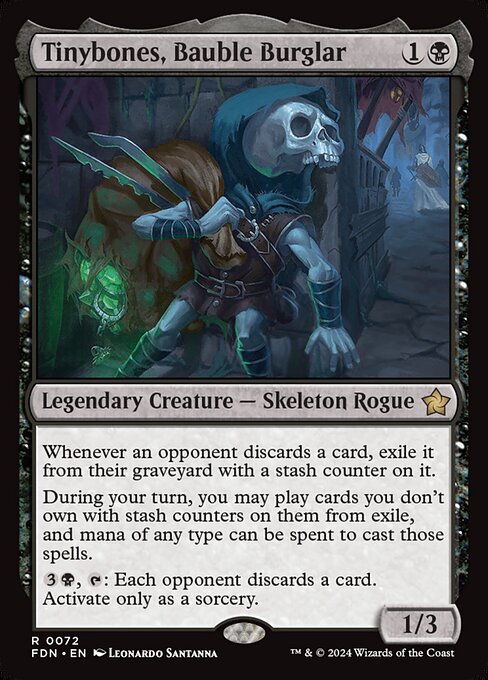
Image courtesy of Scryfall.com
Predictive Data and the Tinybones Advantage
In the evolving world of Magic: The Gathering deckbuilding tools, predictive data is no longer a novelty—it's a necessity. Tinybones, Bauble Burglar, a rare legendary creature from Foundations (fdn), serves as a compact, elegant lens for seeing how foresight can reshape strategy. With a modest {1}{B} mana cost and a sturdy 1/3 body, Tinybones doesn’t just poke at the board; it rewires the way you think about information flow. On one plane, you’ve got a classic discard engine: “Whenever an opponent discards a card, exile it from their graveyard with a stash counter on it.” On the other, you’ve got a wild, flexible payoff: “During your turn, you may play cards you don’t own with stash counters on them from exile, and mana of any type can be spent to cast those spells.” That duality is a perfect proving ground for predictive tooling. 🧙♂️
What makes Tinybones a natural case study is how it encodes two feedback loops into a single design space. The stash counters on exiled cards are not just tokens; they are data-rich signals about what your opponents are discarding and what remains valuable in exile. Predictive deckbuilding tools can capture signals like opponent discard tempo, archetype tendencies, and the frequency with which exiled cards end up being cast. The result is a model that can forecast not just the next draw step, but the moment-to-moment value of each decision point. The ability to spend mana of any type to cast those exiled spells is a raw flexibility metric—a robust feature for predicting line clarity in diverse metas. 🔮
In practice, this leads to smarter recommendations. A predictive engine might weigh Tinybones deployments differently depending on matchup data: in a control-heavy field, the exile mechanic becomes a sanctuary for late-game leverage; in a discard-heavy metagame, Tinybones already shines as a bureau of intelligence, turning opponents’ discarded cards into a personal toolkit. The card’s 2-mana footprint and its rare status also influence tool suggestions about deckbuilding risk—predictive systems can flag the cost/benefit of including a rare engine in budget-conscious builds, while tracking market price signals that accompany non-foil and foil variants. 💎
Designing with Tinybones in Mind: What Predictive Data Looks Like
From a tooling standpoint, Tinybones invites data features that are both intuitive and potent. Here are core signals a deckbuilder tool should consider:
- Opponent discard rate by matchup and tempo, as a predictor of stash-worthy exiles. 🧙♂️
- Expected pool of exiled cards awaiting play, given stash counter accumulation and the current exile landscape.
- Mana flexibility value, since the ability to cast exiled spells with any type of mana reduces color-restriction risk.
- Timing windows for Tinybones’ discard-triggered setup versus its sorcery-speed ability to force discards. ⚔️
- Card rarity, cost, and synergy with graveyard- and exile-themed cards to gauge long-term value and deck cohesion. 🎨
Engineers can translate these signals into dynamic scoring: a Tinybones line might spike in predicted value if an opponent shows a pattern of discarding into graveyards, or it might waver if discard tempo drops. The model can then adjust recommended sideboard choices, tempo plays, and even mulligan heuristics to maximize the chance of exploiting stash counters before the game pivots. This is the kind of data-driven foresight that turns a boutique strategy into a reliable engine. 🎲
Beyond gameplay, Tinybones also highlights the art of data provenance. The card’s design—“play cards you don’t own with stash counters”—presents a unique data-generating mechanism for predictive tools: each stash counter is a living artifact of what has happened previously in the match, and what you anticipate will happen next. That buy-in into the exile-as-reserve concept makes the predictive model more resilient to sudden metagame shifts. 🔥
Practical Takeaways for Builders and Players
For players, the Tinybones toolkit encourages a mindset of readiness and adaptability. A deck built around predictive data doesn’t chase a single combo; it aims to stay liquid, ready to convert information into advantage as the battlefield evolves. For example, if your opponent tends to discard aggressively on early turns, Tinybones’ exile-and-play-from-exile path becomes a profit center—every discarded card is a potential cast later, with mana type no longer a bottleneck. And if you pair Tinybones with other exile- or graveyard-centric pieces, you unlock a cascade of options that feel as if you’re peeking a turn ahead. 🧙♂️ From a design perspective, the card demonstrates how elegant mechanics can yield rich data streams. The stash counters add a tangible, trackable layer that tools can quantify and model, while the “any mana type” clause broadens the space for predictive recommendations across color identities. It’s a reminder that good data models don’t just count things; they interpret how those things interact with the game’s rules and players’ intentions. 💎
And for collectors and enthusiasts, Tinybones continues to be a compelling centerpiece in Foundations’ ongoing conversation about card design and player agency. The aroma of strategy, flavor, and a dash of misdirection is as much part of the experience as the actual gameplay. The art by Leonardo Santanna captures that rakish, shadowy vibe—an aesthetic reminder that every card is a story you can study and enjoy, on and off the table. 🎨
For those curious about the market, Tinybones’ price tag hovers in the accessible range for rare singles, with USD prices around $1.74 for non-foil and a touch higher for foil variants. It’s the kind of card that makes a predictive deckbuilder smile—solid value, strong design, and an engine that teaches us to think ahead, one stash counter at a time. ⚔️
Clear Silicone Phone Case: Slim Profile, Durable & FlexibleMore from our network
- https://crypto-acolytes.xyz/blog/post/sushiswap-vs-curve-which-defi-liquidity-pool-reigns/
- https://blog.digital-vault.xyz/blog/post/design-handoff-to-developers-best-practices-for-smooth-builds/
- https://crypto-acolytes.xyz/blog/post/teff-uncertainties-and-color-index-355-illuminate-a-2600-pc-star/
- https://blog.digital-vault.xyz/blog/post/steer-clear-mastering-color-interactions-and-the-color-pie/
- https://crypto-acolytes.xyz/blog/post/mastering-minecraft-surviving-on-floating-islands/